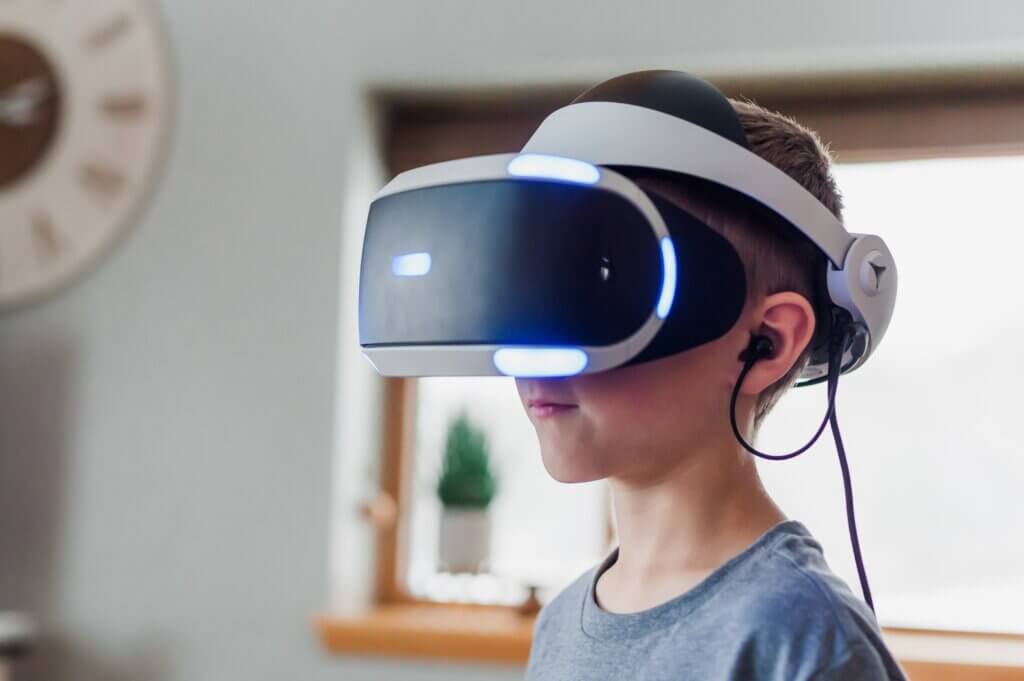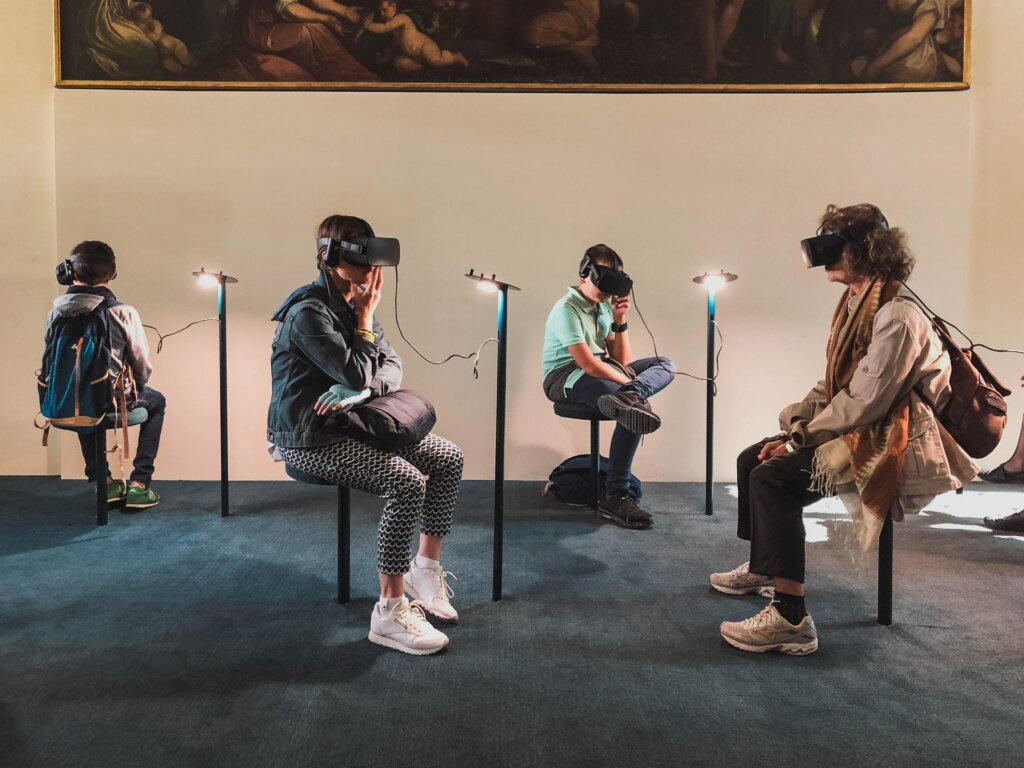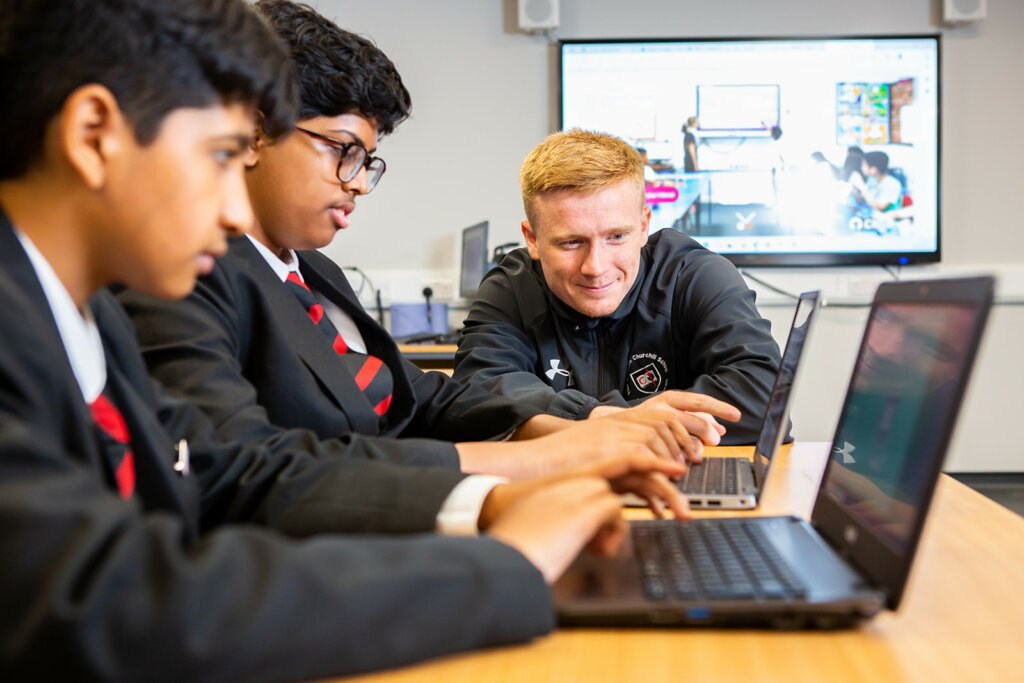
Ranging from high tech devices to cardboard phone holders, you may have seen Virtual Reality (VR) headsets on TV, at friends’ houses, or even have one yourself.
Whatever experience you have with VR, this blog looks to cover the key things parents and carers need to know, as well as some considerations about keeping your children safe when using VR.
What is VR?
VR is a relatively new technology that allows users to fully immerse themselves in a virtual, computer generated world. Users can use headsets to transport themselves to different settings, ranging from realistic cities or locations, to spaceships or a favourite game or movie.
By using screens within headsets, users are fully surrounded by the virtual sights and sounds, and can move and explore by physically moving in the real world.
VR headsets are becoming more widely available, and there is even new equipment out there that allows users to touch and feel things in VR too.
Why do young people like using VR?
VR headsets are an exciting new piece of technology that young people may be increasingly experiencing.
There are many reasons people, both younger and older, may enjoy using VR – not just for fun and leisure, but also for practical and educational reasons too.
From riding on a rollercoaster in space, to transporting back in time to explore Ancient Rome, VR gives a lot of opportunities to experience new things and find out information in an exciting way.
Many young people use VR headsets to play games. Interactive games within VR range across genres, age ratings and interactivity. Many VR games require users to use handsets and headsets to act out actions within a game, and to physically move in the real world in order for the character or avatar to move within the game.
Movement stretches beyond just walking in many VR experiences: for instance, handheld controllers can be linked with the headset to enable using your arms to play tennis, for instance.
What are the age restrictions around VR?
Many VR headsets have a minimum age restriction of 13 years old – this is due to a range of physical and legal restrictions around using this technology.
VR headsets need to take in and process information about us, like where we move and what we look at, for them to work. They also collect data on how long we look at things, ideas about our height and how much our pupils dilate when looking at different things.
It is illegal for companies to collect this data from under 13s in the UK without parental consent, which is why the minimum age to use most VR headset is 13 years old.

Considerations for using VR with young people
If you decide to get a VR headset for your family, or are thinking about getting a headset with a lower age rating, there are some considerations you can take to help keep your family safe when using this technology.
| Consideration | What this means | What you can do |
|---|---|---|
| The content young people might see or experience in VR | VR is designed to make things more realistic and immersive, so violent or gory visuals may be frightening. | Research and test any VR games or experiences before your children use them. Check the age ratings of the games they want to play or apps they want to use on sites such as PEGI or The Family Gaming Database. It is safest to stick to solo experiences (e.g. one player games) and avoid ‘open’ digital spaces where they might interact with people who may not be kind and considerate. You can also stream what they are seeing on to a TV screen. Search how to do this for the devices you have. |
| Risk of injury | As VR relies on a user moving in the offline world, users can get carried away and physically injure themselves or knock over things in the home. Although it may not be a problem for adults, VR headsets can be heavy for younger children and as using VR requires physical movement they may find it difficult or uncomfortable to use technology in this way. | Clear the area where you are using VR, including furniture and cables. Keep an eye on them too, as you can redirect them if they get too close to trip hazards! |
| Physical discomfort using the headset | The headsets used to interact within VR are often designed to be used by adults rather than young people, this can mean that the devices themselves can be heavy for younger users. | Talk to your child about how they feel when using the VR headset and set clear steps they can take if they feel uncomfortable. This could include taking off the headset, only going on for specific amounts of time, or talking to an adult. |
| VR sickness | Similar to ‘car sickness’ VR headsets can make some users feel queasy when using them. Some users find the movement makes them feel nauseous. | Warn your child that this could happen and to take the headset off if they start to feel unwell. |
| Contact from other users | Users of all ages can mix and there are not effective age restrictions in place. Not all users are kind and considerate. When interacting with users in “open” spaces, they may say something inappropriate, or young people may overhear swearing and other unsuitable content. | Some VR headsets allow you to create a virtual bubble around your game character. There is often the option to ‘teleport’ to a safe space or another VR world if other users are an issue. It is possible to block and mute other users too. |
Getting help and reporting in VR
Online safety in VR is improving, but platforms are also keen on creating new experiences and getting more users.
If you want to approach your child about online safety matters and VR, why not create a Family Agreement? It’ll give you a chance to model positive uses of technology that you use yourself, and support your child in learning about and using the safety features in the technology that they use.
The most important thing is to make sure your child knows to turn to you if something worries them online, and having a conversation about life online can help them remember this.
Here are some useful pages to support for those using Meta or PlayStation 5 services:
Meta Quest and Rift S – You can also find a ‘Code of Conduct’.
PlayStation VR2 – The advice is to report through the PlayStation 5 console.


